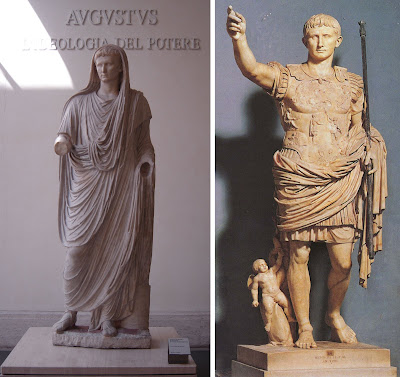Zainab Bahrani, "Salmu: Representation in the Real" in The Graven Image: Representation in Babylonia and Assyria (Philadelphia 2003, 121-148.
Lawrence Berman, "The image of the king in Ancient Egypt" in Pharaohs: Treasures of Egyptian Art from the Louvre (Cleveland 1996), 23-29.
Mary Stieber, "The idea of likeness" in The poetics of appearance in the Attic korai (Austin 2004), 83-113.
I M A G E S
 Portrait-herm-bust of Themistocles. Found in the Caseggiato del Temistocle (V, XI, 2). Museo Ostiense. Second century AD? (original c. 470 BC)
Portrait-herm-bust of Themistocles. Found in the Caseggiato del Temistocle (V, XI, 2). Museo Ostiense. Second century AD? (original c. 470 BC) Tyrannicides, Roman copy of Greek original (c. 480 BC) by Kritios and Nesiotes.
Tyrannicides, Roman copy of Greek original (c. 480 BC) by Kritios and Nesiotes. Left: Portrait bust of Homer (c.850-800 BC) copy after a Greek Hellenistic original; Museo Archeologico Nazionale, Naples.
Left: Portrait bust of Homer (c.850-800 BC) copy after a Greek Hellenistic original; Museo Archeologico Nazionale, Naples.Center: Head of Homer, Epimenides type. Roman copy after a Greek original from 5th century BC. Glyptothek, Munich.
Right: Portrait of Homer, known as Homer Caetani (the bust was found in the walls of the Caetani Palace at Rome). Pentelic marble, Roman copy (2nd century CE) of a Greek original (2nd century BC). Musee du Louvre, Paris.
 Roman bronze bust, the so-called Pseudo-Seneca, now generally identified as an imaginative portrait of Hesiod; Museo Archeologico Nazionale, Naples.
Roman bronze bust, the so-called Pseudo-Seneca, now generally identified as an imaginative portrait of Hesiod; Museo Archeologico Nazionale, Naples.Ruler Portraits
 The victorious Alexander the Great in the Battle of Issus against Persian King Darius in 333 B.C. (Roman mosaic found in the House of the Faun, Pompeii, Italy.)
The victorious Alexander the Great in the Battle of Issus against Persian King Darius in 333 B.C. (Roman mosaic found in the House of the Faun, Pompeii, Italy.) Left: Augustus, the Via Labicana portrait (c. 12 BC); found on slopes of Oppian Hill; National Museum of Rome.
Left: Augustus, the Via Labicana portrait (c. 12 BC); found on slopes of Oppian Hill; National Museum of Rome.Right: Augustus, the Prima Porta portrait (c. 20BC); found in Villa Livia at Prima Porta; Braccio Nuovo, Vatican Museums.
Responses to Rulers
 Portrait of Demosthenes, maybe by Polyeuktos, marble copy of Greek original (c. 280 BC); Glyptothek, Copenhagen.
Portrait of Demosthenes, maybe by Polyeuktos, marble copy of Greek original (c. 280 BC); Glyptothek, Copenhagen. Portrait of Roman patrician with busts of ancestors, also known as the "Barberini Statue", (c. 30 BC); Capitoline Museum, Rome.
Portrait of Roman patrician with busts of ancestors, also known as the "Barberini Statue", (c. 30 BC); Capitoline Museum, Rome. Head of a bearded man, possibly Macrinus (c. 217-250 AD); Harvard Art Museum, Boston.
Head of a bearded man, possibly Macrinus (c. 217-250 AD); Harvard Art Museum, Boston.Precedents for Portraiture: Egypt
 Diorite statue of Chephren (Khafre) from the Valley Temple of Giza; (c. 2565 BC); Egyptian Museum, Cairo.
Diorite statue of Chephren (Khafre) from the Valley Temple of Giza; (c. 2565 BC); Egyptian Museum, Cairo. Colossus of Akhenaten, found at Karnak, Temple of Aten (c. 1353 BC); Egyptian Museum, Cairo.
Colossus of Akhenaten, found at Karnak, Temple of Aten (c. 1353 BC); Egyptian Museum, Cairo. Statue of Mentuemhet, Prince of Thebes; (c. 600 BC); Egyptian Museum, Cairo.
Statue of Mentuemhet, Prince of Thebes; (c. 600 BC); Egyptian Museum, Cairo. Kouros from Attica, (c. 600-590 BC); Metropolitan Museum of Art, New York.
Kouros from Attica, (c. 600-590 BC); Metropolitan Museum of Art, New York.Precedents for Portraiture: Ancient Near East
 Gudea, ruler of Lagash in Southern Mesopotamia; seated diorite statue dedicated to the god Ningishzida (c. 2120 BC); excavated in Telloh (ancient Girsu, Iraq); Musee Louvre, Paris.
Gudea, ruler of Lagash in Southern Mesopotamia; seated diorite statue dedicated to the god Ningishzida (c. 2120 BC); excavated in Telloh (ancient Girsu, Iraq); Musee Louvre, Paris.  Ashurbanipal, last ruler of Assyria,shown in a relief found at his palace in Nineveh (c. 668-624 BC); British Museum, London.
Ashurbanipal, last ruler of Assyria,shown in a relief found at his palace in Nineveh (c. 668-624 BC); British Museum, London. Apollo and Artemis, Siphnian Treasury, N. Frieze Detail (c. 525 BC); Delphi Museum, Greece.
Apollo and Artemis, Siphnian Treasury, N. Frieze Detail (c. 525 BC); Delphi Museum, Greece.Archaic Greece
 Peplos Kore (c. 530 BC); Acropolis Museum, Athens.
Peplos Kore (c. 530 BC); Acropolis Museum, Athens. Kouros of Anavysos, third from the left (c. 540-530 BC); National Museum, Athens.
Kouros of Anavysos, third from the left (c. 540-530 BC); National Museum, Athens. Kore from outskirts of Athens, commemorating Phrasikleia by Aristion of Paros (c. 530 BC).
Kore from outskirts of Athens, commemorating Phrasikleia by Aristion of Paros (c. 530 BC).
No comments:
Post a Comment